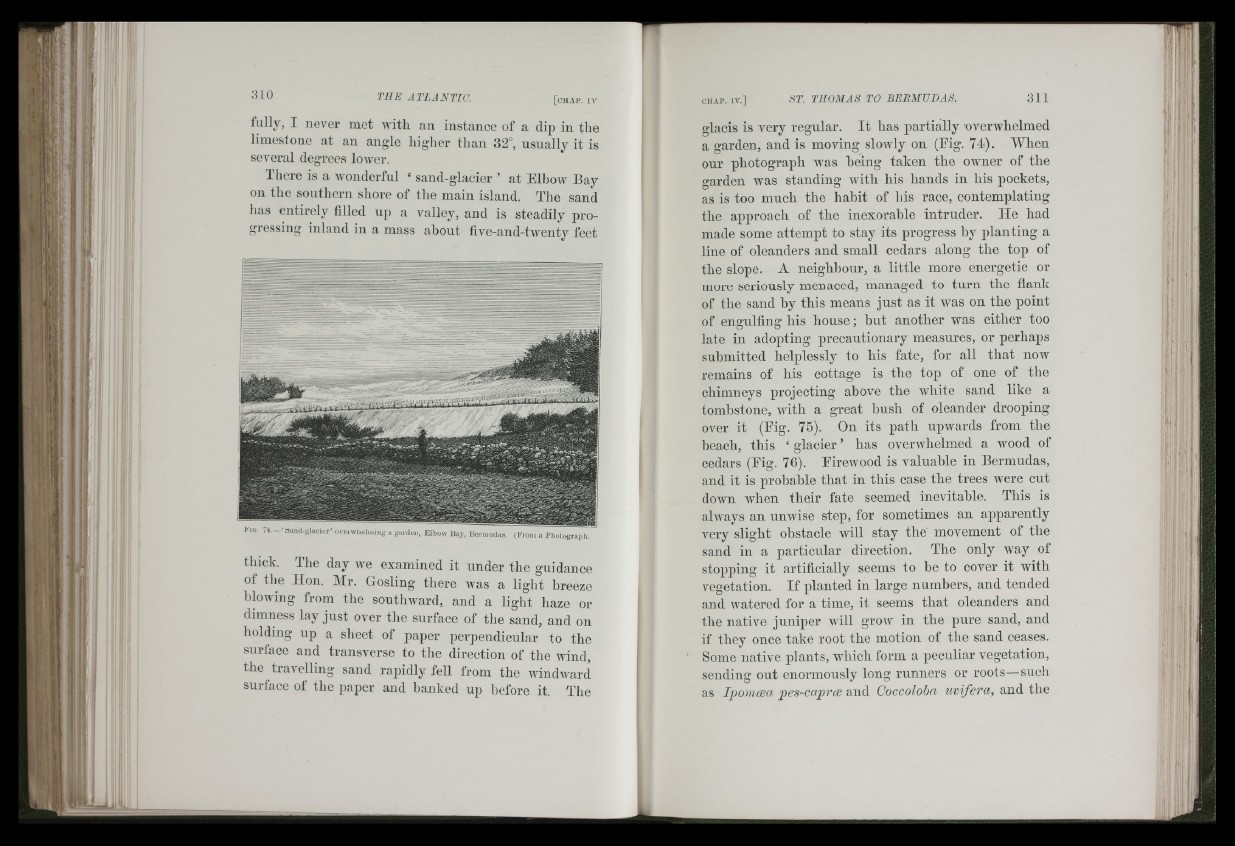
■UI "
'*u
i: 1
k.. , I :
; ^ I
( f f i
: ; :Y .
1 1 i
M -
,T
« Í
!.rSI'. ii 4
fully, I iievei’ met with an instance of a dip in the
limestone at an angle higher than 32°, usually it is
several degrees lower.
There is a wonderful ‘ sand-glacier ’ at Elbmv Bay
on tbe sontbern shore of tbe main island. Tbe sand
lias entirely filled up a valley, and is steadily progressing
inland in a mass about tlve-and-twenty feet
P ig . i 4. —‘ S a iK l-g la c ic r'o v e rw iie liiiiiig a gardBii, Jilbow Hay, Her■iiiudas. (Fi'oiu a P lio lo g rap li.
thick. The day we examined it under the guidance
of tbe Hon. Mr. Gosling there was a light breeze
blowing from the southward, and a light haze or
dimness lay just over tlie surface of the sand, and on
holding up a sheet of paper perpendicular to the
surface and transverse to the direction of tbe wind,
the travelling sand rapidly fell from the windward
surface of the paper and banked up before it. The
glacis is very regular. It has partially overwhelmed
a garden, and is moving slowly on (Eig. 74). When
our photograph was heing taken the owner of the
garden Avas standing with his hands in his pockets,
as is too much the habit of his race, contemplating
the approach of the inexorable intruder. He had
made some attempt to stay its progress hy planting a
line of oleanders and small cedars along the top of
the slope. A neighbour, a little more energetic or
more seriously menaced, managed to turn the flank
of the sand by this means just as it was on the point
of engulfing his house; but another was either too
late in adopting precautionary measures, or perhaps
submitted helplessly to his fate, for all that now
remains of his cottage is the top of one of the
chimneys projecting above the white sand like a
tombstone, with a great bush of oleander drooping
over it (Eig. 75). On its path upwards from the
beach, this ‘ glacier ’ has overwhelmed a AVOod of
cedars (Eig. 76). Eirewood is valuable in Bermudas,
and it is probable that in this case the trees were cut
down when their fate seemed inevitable. This is
always an unwise step, for sometimes an apparently
very slight obstacle Avill stay the movement of the
sand in a particular direction. The only way of
stopping it artificially seems to be to cover it with
vegetation. I f planted in large numbers, and tended
and watered for a time, it seems that oleanders and
the native juniper will groAV in the pure sand, and
if they once take root the motion of the sand ceases.
Some native plants, which form a peculiar vegetation,
sending ont enormously long runners or roots—such
as Ipomoja pes-caprce and Coccoloha iivifera, and the
h, i¥ '
I:
biq
!’?! ’
I G i